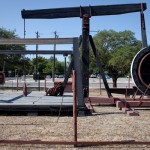Why Gulf Coast Refineries Started 2013 With Less Oil

Graph by Energy Information Administration (EIA)
A new federal analysis shows that oil inventories at Gulf Coast refineries typically decline in December, as companies have to pay their taxes.
Despite a drilling bonanza in Texas and other parts of the country leading to high levels of domestic oil and gas production, gasoline prices have been on the rise lately. Since mid-January, average prices at the pump went up from $3.37 to $3.81. It’s a bit of a head-scratcher: if we’re producing more and more of our own oil, why are we paying more for it?
Common answers to that puzzling question have pointed to more demand in China, conflict in the Middle East and shutdowns at some refineries. And, of course, the reality is that no matter how much oil we produce, it’s traded on a global market that’s out of our control.
And a new federal analysis possibly points out another small, temporary piece of the puzzle: oil refiners on the Gulf Coast that are trying to pay less in taxes.
The amount of oil at Gulf Coast refineries usually takes a big drop in the month of December, on average a decline of 8 million barrels, according to the Energy Information Administration (EIA). The analysis says that this doesn’t mean the oil market is tightening overall, it just comes down to how much supply Gulf Coast refineries have on hand when they pay their taxes.
“The reason for this sharp decline: December 31 is the typical assessment date for taxes on crude oil stocks that are collected by many states/counties/municipalities in regions where the bulk of U.S. crude oil and petroleum product inventories are stored,” the agency writes in an analysis this week. “To decrease crude inventories, companies can do a combination of the following: delay or decrease imports, increase runs at refineries, move crude oil out of the taxable region, or sell crude oil to other market participants.”
Parts of Texas and Lousiana assess their taxes on oil inventories at the end of December. So in short, the less oil those Gulf Coast refineries have on hand at that time, the less they pay in taxes. The good news? Those inventories generally come back in January.
